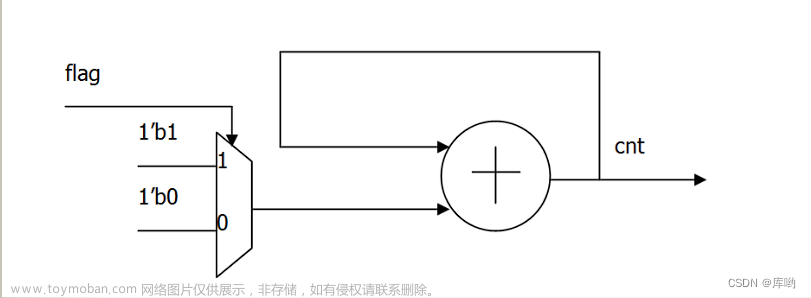1. D flip-flop D触发器

module top_module (
input clk, // Clocks are used in sequential circuits
input d,
output reg q );//
// Use a clocked always block
// copy d to q at every positive edge of clk
// Clocked always blocks should use non-blocking assignments
always@(posedge clk) //固定格式
begin
q <= d ; // 非阻塞赋值,顺序执行
end
endmodule2. D flip-flop D触发器

module top_module (
input clk,
input [7:0] d,
output [7:0] q
);
// Because q is a vector, this creates multiple DFFs.
always@(posedge clk)
begin
q <= d ;
end
endmodule3. DFF with reset 带复位的D触发器

module top_module (
input clk,
input reset, // Synchronous reset
input [7:0] d,
output [7:0] q
);
always @(posedge clk)
begin
if(reset)
q <= 8'b0;
else
q <= d ;
end
endmodule4. 带复位值的D触发器

module top_module (
input clk,
input reset,
input [7:0] d,
output [7:0] q
);
always@(negedge clk)
begin
if(reset)
q <= 8'H0x34 ;
else
q<=d;
end
endmodule5. DFF with asynchronous reset 带异步复位功能的 D触发器

module top_module(
input clk,
input [7:0] d,
input areset,
output reg [7:0] q);
// The only difference in code compared to synchronous reset is in the sensitivity list.
always @(posedge clk, posedge areset)
if (areset)
q <= 0;
else
q <= d;
// In Verilog, the sensitivity list looks strange. The FF's reset is sensitive to the
// *level* of areset, so why does using "posedge areset" work?
// To see why it works, consider the truth table for all events that change the input
// signals, assuming clk and areset do not switch at precisely the same time:
// clk areset output
// x 0->1 q <= 0; (because areset = 1) 上升沿触发 复位
// x 1->0 no change (always block not triggered)
// 0->1 0 q <= d; (not resetting) 上升沿触发 复位
// 0->1 1 q <= 0; (still resetting, q was 0 before too) 复位
// 1->0 x no change (always block not triggered)
endmodule6. DFF with byte enable 带位启动的触发器

module top_module (
input clk,
input resetn,
input [1:0] byteena,
input [15:0] d,
output [15:0] q
);
always@(posedge clk)
begin
if(!resetn)
q <= 16'b0;
else
begin
if(byteena[0])
q[7:0] <= d[7:0];
if(byteena[1])
q[15:8] <=d[15:8];
end
end
endmodule7. D Latch D锁存器

module top_module (
input d,
input ena,
output q);
always@(*)
begin
if(ena)
q<=d;
end
endmodule8. DFF

module top_module (
input clk,
input d,
input ar, // asynchronous reset 异步复位
output q);
always@(posedge clk, posedge ar) //异步复位,always语句条件需要注明
begin
if(ar)
q<=1'b0;
else
q<=d;
end
endmodule9. DFF

文章来源:https://www.toymoban.com/news/detail-765546.html
module top_module (
input clk,
input d,
input r, // synchronous reset 同步复位
output q);
always@(posedge clk)
begin
if(r)
q<=0;
else
q<=d;
end
endmodule10. DFF+gate

module top_module (
input clk,
input in,
output out);
always@(posedge clk)
begin
out<=in^out;
end
endmodule11. Mux and DFF


module top_module (
input clk,
input L,
input r_in,
input q_in,
output reg Q);
wire D;
assign D=L?r_in:q_in; //多路复用器
always@(posedge clk) //触发器
begin
Q<=D;
end
endmodule12. DFFs and gates

module top_module (
input clk,
input w, R, E, L,
output Q
);
wire W,D; //多路复用器
assign W=E?w:Q;
assign D=L?R:W;
always@(posedge clk) //触发器
begin
Q<=D;
end
endmodule13. DFFs and gates

module top_module (
input clk,
input x,
output z
);
wire Q1,Q2,Q3;
wire D1,D2,D3;
assign D1=x^Q1;
assign D2=x&~Q2;
assign D3=x|~Q3;
assign z=~(Q1|Q2|Q3);
always@(posedge clk)
begin
Q1<=D1;
Q2<=D2;
Q3<=D3;
end
endmodule14. Create circuit from turth table

module top_module (
input clk,
input j,
input k,
output Q);
wire D;
assign D=j&~Q | ~k&Q;
always@(posedge clk)
begin
Q<=D;
end
endmodule15. Detect and edge 输入的单边沿检测

module top_module (
input clk,
input [7:0] in,
output [7:0] pedge
);
reg [7:0] mid;
always@(posedge clk)
begin
mid<=in; //把上一周期的in值赋给mid
pedge<=~mid∈ //上一周期in为0,这一周期in为1,pedge才会有值
end
endmodule16. Detect both edges 输入的双边沿检测

module top_module (
input clk,
input [7:0] in,
output [7:0] anyedge
);
reg [7:0]mid;
always@(posedge clk)
begin
mid<=in; //把上一周期的In值赋给mid
anyedge <= ~mid&in | mid&~in ; //上一周期0现在1 或者 上一周期1现在0
end
endmodule17. Edge capture register 边沿捕获寄存器

module top_module (
input clk,
input reset,
input [31:0] in,
output [31:0] out
);
reg [31:0] mid;
always@(posedge clk)
begin
mid <= in;
if(reset)
out <= 4'h0; //复位前保持高电平,复位后变为低电平
else
out <= mid&~in | out ; // |out 表示 会保持高电平,直到收到复位信号
end
endmodule18. Dual-edge triggered flip-flop 时钟的双边沿捕获

module top_module (
input clk,
input d,
output q
);
reg q0,q1;
always@(posedge clk)
begin
q0 <= d; //q0为上升沿触发的输出
end
always@(negedge clk)
begin
q1 <= d; //q1为下降沿触发的输出
end
assign q = clk?q0:q1; //根据时钟clk决定,最终使用哪一段 输出
endmodulemodule top_module(
input clk,
input d,
output q);
reg p, n;
// A positive-edge triggered flip-flop
always @(posedge clk)
p <= d ^ n;
// A negative-edge triggered flip-flop
always @(negedge clk)
n <= d ^ p;
// Why does this work?
// After posedge clk, p changes to d^n. Thus q = (p^n) = (d^n^n) = d.
// After negedge clk, n changes to d^p. Thus q = (p^n) = (p^d^p) = d.
// At each (positive or negative) clock edge, p and n FFs alternately
// load a value that will cancel out the other and cause the new value of d to remain.
assign q = p ^ n;
// Can't synthesize this.
/*always @(posedge clk, negedge clk) begin
q <= d;
end*/
endmodule文章来源地址https://www.toymoban.com/news/detail-765546.html
到了这里,关于verilog 学习笔记 —— 时序逻辑 Sequential Logics (Latches and Flip-Flops 锁存器和触发器)的文章就介绍完了。如果您还想了解更多内容,请在右上角搜索TOY模板网以前的文章或继续浏览下面的相关文章,希望大家以后多多支持TOY模板网!












